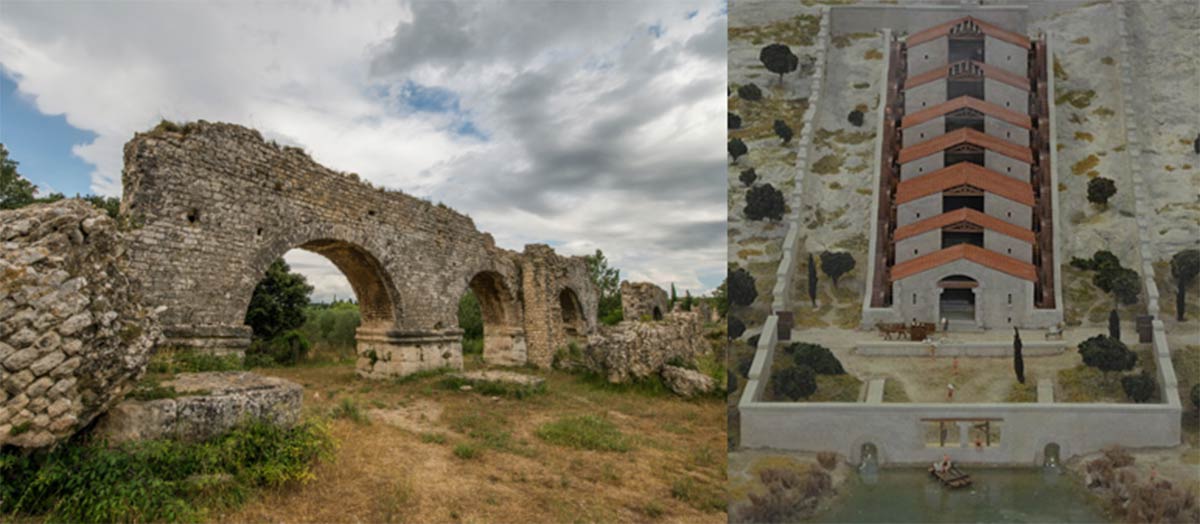Engineering Secrets of Barbegal Mills, The World’s First Industrial Complex, Uncovered
The 2nd century CE Roman Barbegal watermill complex, a unique cluster of 16 waterwheels in southern France, was the first known attempt in Europe to set up an industrial-scale complex of machines.

The Romans were among the finest engineers in the ancient world. Among the most impressive of their engineering feats was the Barbegal mills and aqueduct. This is a complex of watermills located in southern France and is regarded as one of the world’s first industrial complexes. A team of researchers have now solved the mystery of the Barbegal mills’ hydraulics and its workings.
The team of scientists led by Professor Cees Passchier of the Johannes Gutenberg University Mainz in Germany investigated the complex. Little is known about the hydraulics and technologies that powered the Barbegal mills. This is despite the fact that mills and other forms of hydraulic engineering were very important in the economy and society of Rome.

Model of the water mills at Barbegal in Musée de l’Arles antique. (Carole Raddato/CC BY SA 2.0)
The researchers wrote in Nature that ‘from as early as the first century BC, watermills were among the first energy sources not depending upon human or animal muscle power.’ Roman watermills influenced Medieval monks’ mills, and they in turn influenced the hydropower technologies of the Industrial Revolution in the 18th century in Britain.
One of the World’s Earliest Industrial Complexes
The Barbegal aqueduct and mills are located 7.47 miles (12 kilometers) north of Arles. The mills were fed by the Arles aqueduct and are set on a hill. In total 16 water mills descended the rock incline. The water channels and ruins of the individual mills can still be seen. They date from the Second Century AD, when the Roman Empire and its economy was at its zenith, under rulers such as Hadrian.
The researchers wrote in Nature that ‘Since the upper part of the Barbegal mill complex has been destroyed and no traces of the wooden machinery survived, the mode of operation of these mills has long remained elusive.’ So, the team of scientists set out to solve the mystery of how the Barbegal mills worked.

View of the ruins of the Barbegal mill complex in 2018. (Robert Fabre)
The Ingenious Design of Water Channels
The researcher examined carbonate deposits that were stored in a museum in Arles that came from the mill. The carbonate deposits had ‘formed inside wooden millrun flumes, the elevated gutters that once transported water to the mill,’ the researchers wrote in Nature. When examining these deposits, they found something very unusual. The experts found the imprints of an elbow-shaped flume, which is an inclined channel for transporting water.
They measured a model of the flume and compared it to the water basins of the mill. They were baffled. Professor Passchier told Science Daily that they ‘were able to show that the flume to which this elbow-shaped piece belonged very likely supplied the mill wheels in the lower basins of the complex with water.’ Yet the shape of the chute was not like anything found before from the Greco-Roman World – or even from later periods. Science Daily quotes Prof. Passchier as saying that “We were therefore puzzled as to why the flume was designed this way and what it was used for.”

Carbonate segments of the Barbegal elbow flume. (C. C. W. Passchier et al., 2020/Nature)
The Engineering Techniques Used at Barbegal Mills
What really mystified the researchers was that it did not provide any discernible advantages. The Professor is quoted by Science Daily as saying that “However, our calculations show that the oddly shaped flume is a unique adaptation for the Barbegal mills.”
They found that the elbow-shaped channel was inclined slightly against the current and this increased the flow of water in part of the flume. Yet at the same time, the water jet to the wheels of the mill was at the correct velocity and angle. This was much more effective for this particular mill complex than the traditional method, using straight flumes.

Three plausible models to place an elbow-flume in the wheel pits of the Barbegal complex with matching hydraulic models at right. (C. C. W. Passchier et al., 2020/Nature)
Based on the finds, the experts were able to develop a model of the Barbegal aqueduct and mills and have finally solved the mystery of how it works. This discovery shows the extraordinary ingenuity of Roman engineers.
During the research, the team also found that ‘the wood of the flume was probably cut with a mechanical, water-powered saw, which is possibly the first documented mechanical wood saw,’ according to Science Daily. This finding was based on the regular cuts with straight spacing on the imprint of the chute. This can help to explain some of Rome’s many advanced engineering achievements.
This study has shown the value of carbonate deposits to the history of science and technology. It can help researchers to understand how aqueducts and mills were designed in the past. The researchers wrote in Nature that ‘this knowledge can be useful for hydrologists to identify which springs can be regenerated or reused, or how depletion can be mitigated, for instance as a result of climate change.’ In this way, the study of deposits can also help scientists to identify and preserve possible water sources in arid regions.
Related Post
A shocking documentary proves that mermaids do exist
SHOCKING Revelation: Thuya, Mother of Queen Tiye, Was the Grandmother of Akhenaten and Tutankhamun—What Ancient Egyptian Secrets Did She Leave Behind?
Breaking News: Astonishing Discoveries at Karahan Tepe Confirm an Extraterrestrial Civilization is Hiding on Earth, and NO ONE Knows!
Breaking News: Researchers FINALLY Discover U.S. Navy Flight 19 After 75 Years Lost in the Bermuda Triangle!
NASA’s Secret Investigation: Uncovering the Astonishing Mystery of the UFO Crash on the Mountain!
Explosive UFO Docs LEAKED: Startling Proof That Aliens Ruled Ancient Egypt!